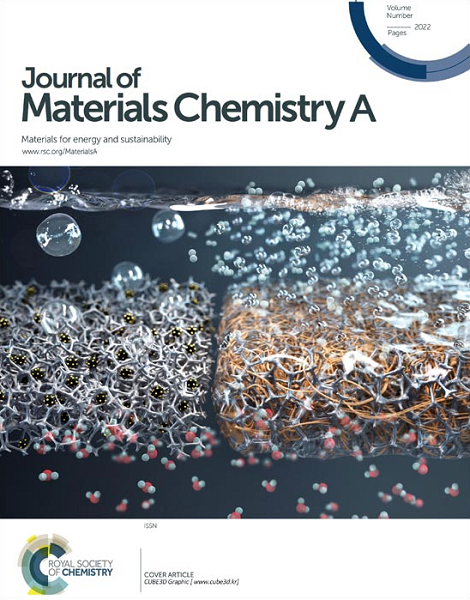Study on mechanisms of two-step hydrogen sorption in MgH2-TiCrMnFeZr high-entropy alloy composite
IF 10.7
2区 材料科学
Q1 CHEMISTRY, PHYSICAL
引用次数: 0
Abstract
High-entropy alloys (HEAs) featuring with multi-element active sites show exclusive catalytic ability, as well as great potential to store hydrogen (H2) at room temperature by adjusting the electronic and geometrical factors. Herein, a TiCrMnFeZr HEA was adopted to improve the hydrogen storage properties of magnesium hydride (MgH2). It was demonstrated that MgH2 provides substantial cushion protection for the crystal structure and hydrogen storage capacity of TiCrMnFeZr HEA during the ball milling, while the TiCrMnFeZr HEA exhibits superior catalytic ability to the dissociation of H-H and Mg-H bonds. Particularly, the MgH2-40 wt.% TiCrMnFeZr composite can absorb and desorb 0.72 wt.% H2 even at room temperature. Moreover, MgH2 starts to release hydrogen at 162 oC, and 90 % of stored H2 (~3.7 wt.%) can be released at 230 oC within 60 min. There is no capacity fading after 20 cycles at 300 oC for both TiCrMnFeZr HEA and Mg/MgH2 phases in the composite, showing an outstanding cyclic performance. Microstructure investigations reveal that the well-protected TiCrMnFeZr HEA particles surfaces perform as the catalytic sites for the dissociation of Mg-H bonds because of its intrinsic multivalent electronic configuration, and also serve as the channels for hydrogen sorption in Mg/MgH2. Such a method to design and synthesize high-performance Mg-based hydrogen storage composites and to provide H2 in two steps paves a new way to realize their practical applications in the hydrogen energy field.MgH2-TiCrMnFeZr高熵合金复合材料两步吸氢机理研究
具有多元素活性位点的高熵合金(HEAs)具有独特的催化能力,通过调节电子和几何因素,在室温下具有很大的储氢潜力。本文采用TiCrMnFeZr HEA来改善氢化镁(MgH2)的储氢性能。结果表明,在球磨过程中,MgH2对TiCrMnFeZr HEA的晶体结构和储氢能力提供了实质性的缓冲保护,而TiCrMnFeZr HEA对H-H和Mg-H键的解离具有较强的催化能力。特别是,MgH2-40 wt.% TiCrMnFeZr复合材料即使在室温下也能吸附和解吸0.72 wt.%的H2。此外,MgH2在162℃时开始释放氢气,在230℃时60 min内可释放90%的储氢(~3.7 wt.%)。复合材料中TiCrMnFeZr HEA和Mg/MgH2相在300℃下循环20次后均没有容量衰减,表现出优异的循环性能。微观结构研究表明,保护良好的TiCrMnFeZr HEA颗粒表面由于其固有的多价电子构型而成为Mg- h键解离的催化位点,同时也是Mg/MgH2中吸氢的通道。这种设计合成高性能镁基储氢复合材料并分两步提供氢气的方法,为实现其在氢能领域的实际应用开辟了新的途径。
本文章由计算机程序翻译,如有差异,请以英文原文为准。
求助全文
约1分钟内获得全文
求助全文
来源期刊

Journal of Materials Chemistry A
CHEMISTRY, PHYSICAL-ENERGY & FUELS
CiteScore
19.50
自引率
5.00%
发文量
1892
审稿时长
1.5 months
期刊介绍:
The Journal of Materials Chemistry A, B & C covers a wide range of high-quality studies in the field of materials chemistry, with each section focusing on specific applications of the materials studied. Journal of Materials Chemistry A emphasizes applications in energy and sustainability, including topics such as artificial photosynthesis, batteries, and fuel cells. Journal of Materials Chemistry B focuses on applications in biology and medicine, while Journal of Materials Chemistry C covers applications in optical, magnetic, and electronic devices. Example topic areas within the scope of Journal of Materials Chemistry A include catalysis, green/sustainable materials, sensors, and water treatment, among others.
 求助内容:
求助内容: 应助结果提醒方式:
应助结果提醒方式:


